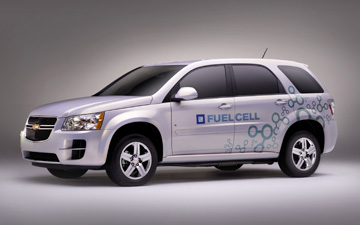
NEW YORK – General Motors Corp. executives consider it high compliment when told a drive in their still-experimental Chevrolet Equinox Fuel Cell vehicle is nothing special.
But that’s pretty much the case – and that means the auto maker is meeting its top objective with the high-tech cross/utility vehicle.
GM will build 100 Equinox FCs for its “Project Driveway” test program that will put the vehicles in the hands of average people in New York, Los Angeles and Washington for up to three months to get their reaction to owning and operating a fuel-cell vehicle.
GM is selecting the drivers from more than 11,000 applications it has received online thus far, and it is dedicating a staffer, called the driver relationship manager, to assist each of these temporary owners around the clock during their time with the vehicle.
Over the 30-month test program, the auto maker expects to put thousands of people behind the wheel for at least brief test drives.
The more people think the Equinox FC looks and acts like any other CUV, the closer GM is to making the potential transition to the hydrogen economy a seamless one.
The Equinox FC looks like a production Equinox, save for the graphics, bigger grille opening and cooling ducts up front and four rectangular exhaust pipes out the back. Part of its cargo bay is compromised by one of the three hydrogen fuel tanks that forms a hump in the floor, and there are only four seats instead of five to keep weight down.

Under the hood there are no belts, pulleys, hoses, dipsticks or filler tubes, just a neatly packaged 400-volt fuel cell topped by a complex, power module distribution center – a squat, rectangular box that looks like some new-generation TiVo. The only routine maintenance not requiring a degree from MIT is the re-filling of the washer fluid reservoir, which is accessed from the cargo compartment.
There’s a small storage bin under the rear cargo floor to keep items from rolling around the back, but there’s no spare tire. Instead, a tire-repair kit is concealed behind a side panel.
Refueling may present the biggest challenge for test drivers. Behind the side fuel door is a connector that looks like it was taken right off the space shuttle.
However, before fitting the hydrogen refueling hose, an electrical connection must be established between pump and vehicle. A separate electrical port is housed in the back behind the license plate. But the vehicle also can make the connection automatically, if the service station is equipped with the necessary infrared technology.
Refueling wasn’t part of our test drive, but GM says it takes about 6-8 minutes to refill the three 10-gallon (38 L) tanks. One refueling station is being set up in nearby White Plains and GM expects several stations to be available to testers in California.
The Equinox FC comes well equipped. Standard are 17-in. aluminum wheels, 4-wheel antilock brakes with StabiliTrak and roof-rail side-impact airbags. Amenities include full service OnStar telematics, a navigation system and XM satellite radio.

Instrumentation is fairly standard, except the tachometer is replaced by a kilowatt gage that indicates how much electricity is being used or how much is being put back into the battery by the regenerative brakes.
A graphic display on the navigation screen shows the direction and speed of the electrical flow, but that’s simply an unwanted distraction when driving here, where there’s too many pedestrians and overly aggressive cabbies to dodge.
Once started, a process that GM says takes minutes (test cars already were fired up prior to our drive here), a green car icon appears near the speedometer to signal the vehicle is ready to go.
The Equinox FC runs almost silently, with the electric motor pleasantly tuned and not at all whiny as might be expected.
There is no transmission – drive is direct to the front wheels, but the Equinox FC offers two “gear” settings via the console-mounted shifter, drive and low. The latter can be used any time but mostly is for descending steep grades, where it helps slow the vehicle by engaging the regenerative braking.
GM says the combination of the fuel cell and a 35-kw battery that acts like a turbocharger when a burst of power is needed equates to 126 hp and 236 lb.-ft. (320 Nm) of torque. That gets the Equinox FC to 60 mph (97 km/h) from a dead stop in a diesel-like 12 seconds, GM says.
But because the electric drive delivers torque instantaneously, the vehicle feels much quicker off the line than that, and it easily shoots the traffic gaps here or makes the last-second dash through a suddenly collapsing intersection.
Top speed is 100 mph (161 km/h), according to GM, but we never approached anything close to that in our 90-minute test drive that covered little more than eight miles (13 km) around New York’s Chelsea district. Fuel economy is listed at a gasoline equivalent of 35/45 mpg (6.7-5.2 L/100 km), and the vehicle has a range of 150 miles (241 km) on full tanks.
Stopping takes some getting used to, with the regenerative braking system a bit grabby. GM engineers say that can be dialed down, but doing so would diminish some of the battery-recharging capability. Feedback from test drivers will help determine the brake setup in any future fuel-cell vehicles to come.
But in all, the system works, and you don’t feel like you’re driving a science fair project, even though each of the 100 Equinox FCs costs about as much as an auto show concept car.
Whether such vehicles make it into production will depend mostly on cost, infrastructure and the ability to produce in volume things like the fuel cell and onboard hydrogen storage tanks.
But, if nothing else, GM appears to be on a track to proving this technology is highly drivable.




